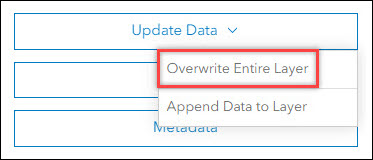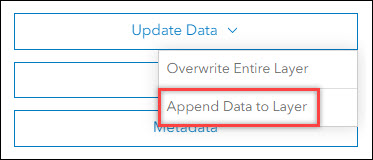Frequently asked question
What are the differences between overwriting and appending data in ArcGIS Online?
In some cases, an ArcGIS Online hosted feature layer must be constantly updated with newly collected data to ensure the feature layer is always updated with the latest data. When ArcGIS Data Pipelines cannot be used to streamline the automation of data updates, ArcGIS Online provides two methods to achieve this, depending on how the data must be updated: overwrite or append. This article describes the differences between overwriting and appending data to a hosted feature layer in ArcGIS Online.
Note: Only the owner of the hosted feature layer or the organization's administrator is allowed to overwrite or append data to the feature layer.
Overwriting data in ArcGIS Online
Overwriting a feature layer in ArcGIS Online replaces the entire content of the service, including all the layers and other data, with data from an updated source file. All layers in the feature layer collection are updated at once, making it the most ideal option when doing bulk operations.
To update the data in hosted feature layers published from a file geodatabase, shapefile, GeoJSON file, Microsoft Excel file, or CSV file, overwrite the data with data from an updated source file by clicking Update Data > Overwrite Entire Layer on the layer's item page. Refer to ArcGIS Online: Overwrite hosted feature layers for more information. The data file used to overwrite must be of the same format and filename as the original that was used to publish the layer. The schema (column names, column data types) of the data file must be the same as the original. This overwriting method maintains the layer URL, layer properties (that were initially set on the item page), symbology, and pop-up configurations.

The overwrite option is not available in the item details page for feature layers published from ArcGIS Pro. Refer to FAQ: Why is the Overwrite Entire Layer option not available in ArcGIS Online? for more information. To overwrite the layer, share the updated layer using ArcGIS Pro and select the Overwrite Web Layer option. Refer to ArcGIS Pro: Overwrite a web feature layer for the workflow. This overwriting method preserves the original feature layer item ID, settings and metadata. However, all of the previous pop-up configurations, symbology, or custom fields (Arcade) that are previously added to the feature layer will be lost and replaced with the one in the source layer(s) in ArcGIS Pro. To automate the overwriting process, use the overwrite function in ArcGIS API for Python. Refer to ArcGIS Pro: Automate sharing web layers for more information.
Appending data in ArcGIS Online
The append task in ArcGIS Online is performed to add new data to an existing feature layer. This option is ideal when, for example, new data from a weekly generated data source must be added to an existing feature layer without overwriting the entire layer. It is also best performed when there is an existing feature that needs an update, or the amount of data to update is relatively small.
To append data to a hosted feature layer directly in ArcGIS Online, click Update Data > Append Data to Layer on the layer’s item page. Refer to ArcGIS Online: Append data to layers for more information. Appending data to the feature layer does not alter the layer's schema, layer URL, symbology, and pop-up configurations. However, the layer's contents are edited during the appending process, which updates the 'Data updated' date on the layer's item page.

The Append tool in ArcGIS Pro can be used to add features from a local feature class to an existing feature layer in ArcGIS Online. Refer to How To: Update a hosted feature layer in ArcGIS Online with data from a feature class in ArcGIS Pro for more information.
Article ID: 000028667
- ArcGIS Online
- ArcGIS Pro 3 0
- ArcGIS Pro 2 8 x
- ArcGIS Pro 2 x
Get help from ArcGIS experts
Start chatting now

